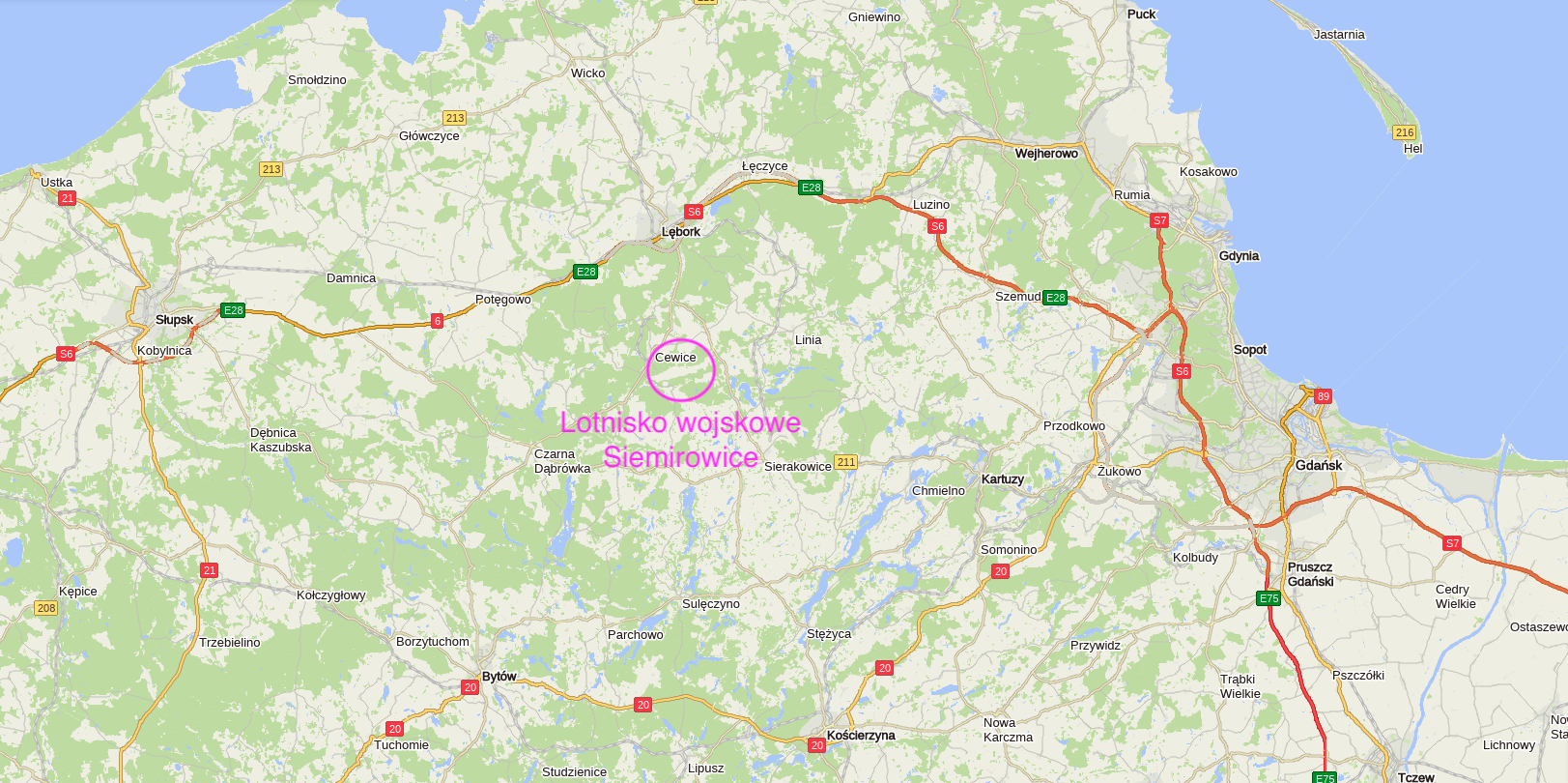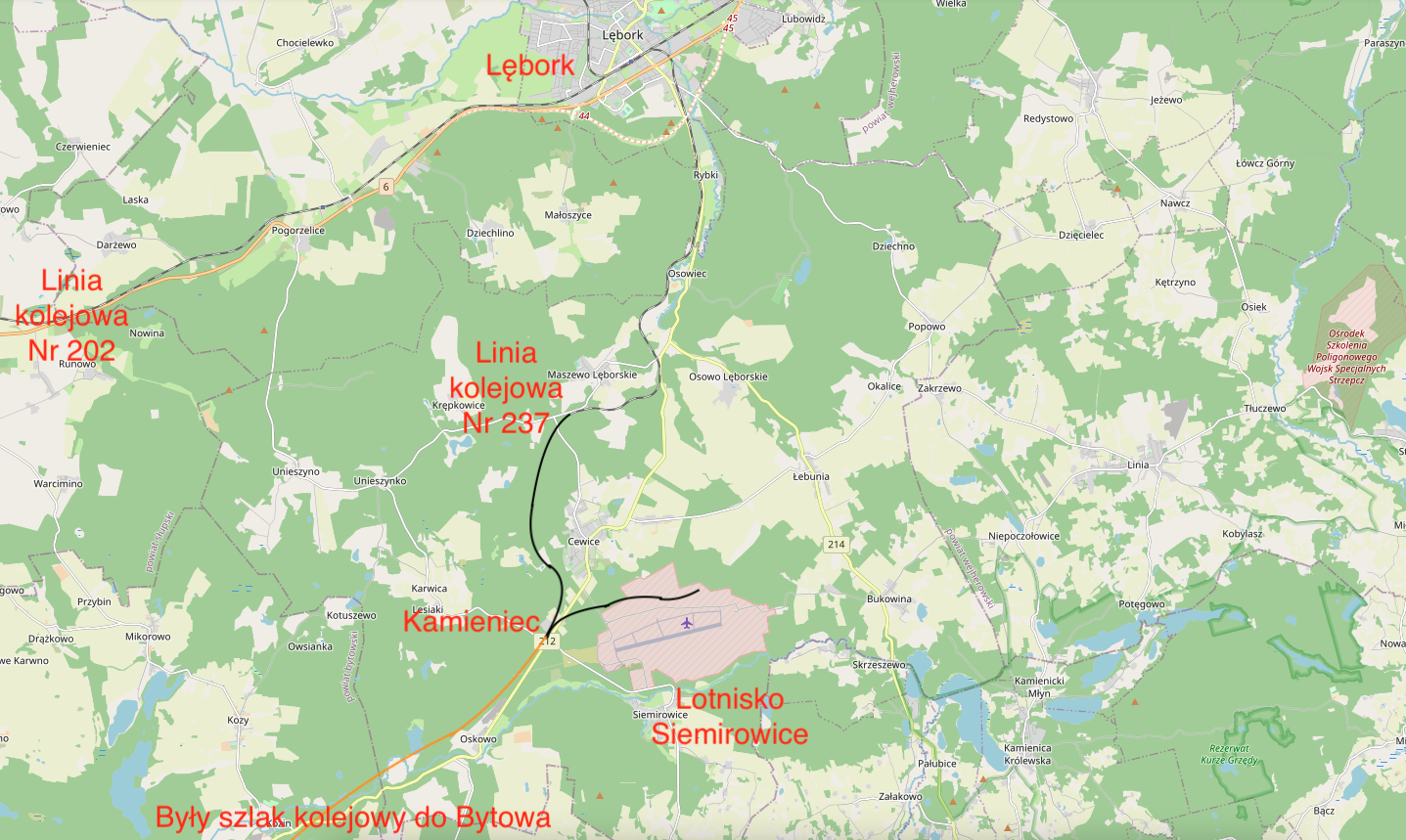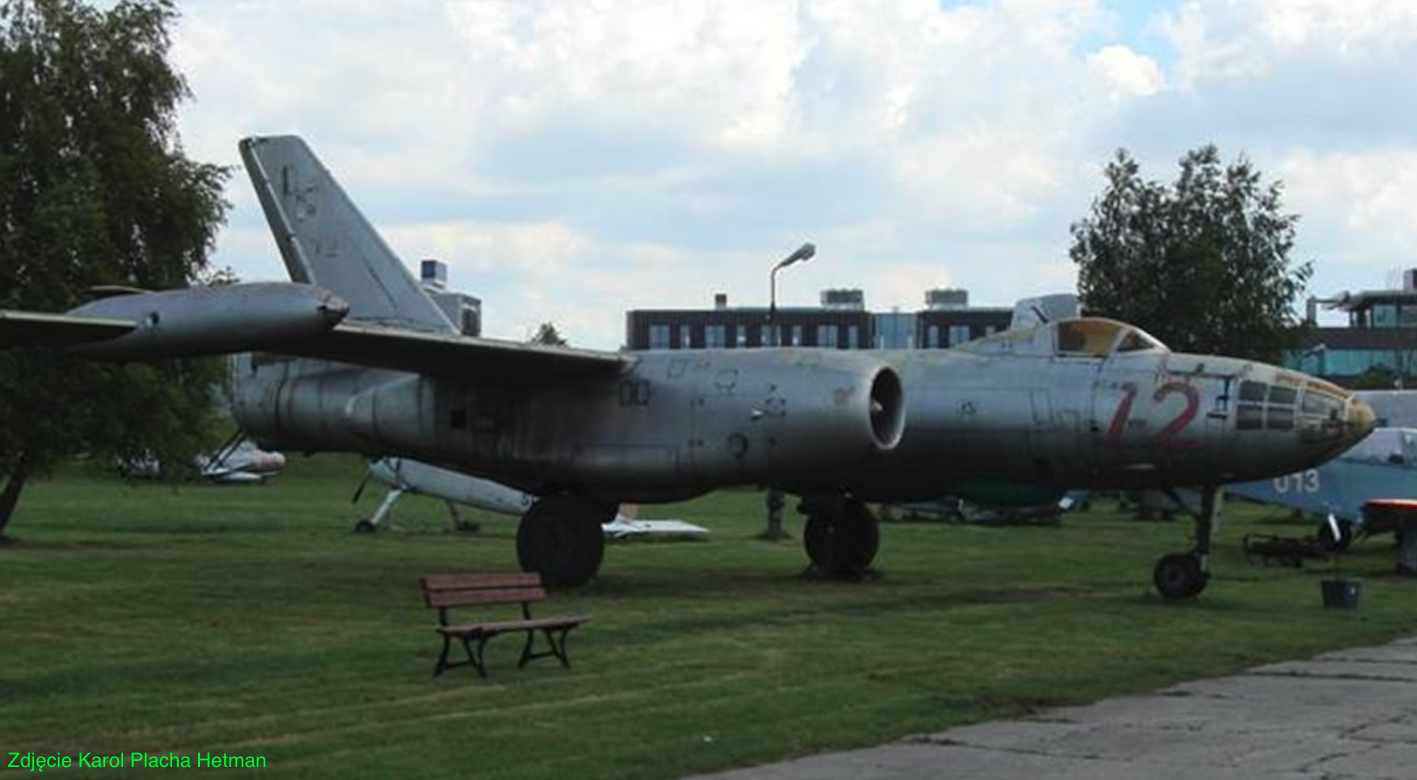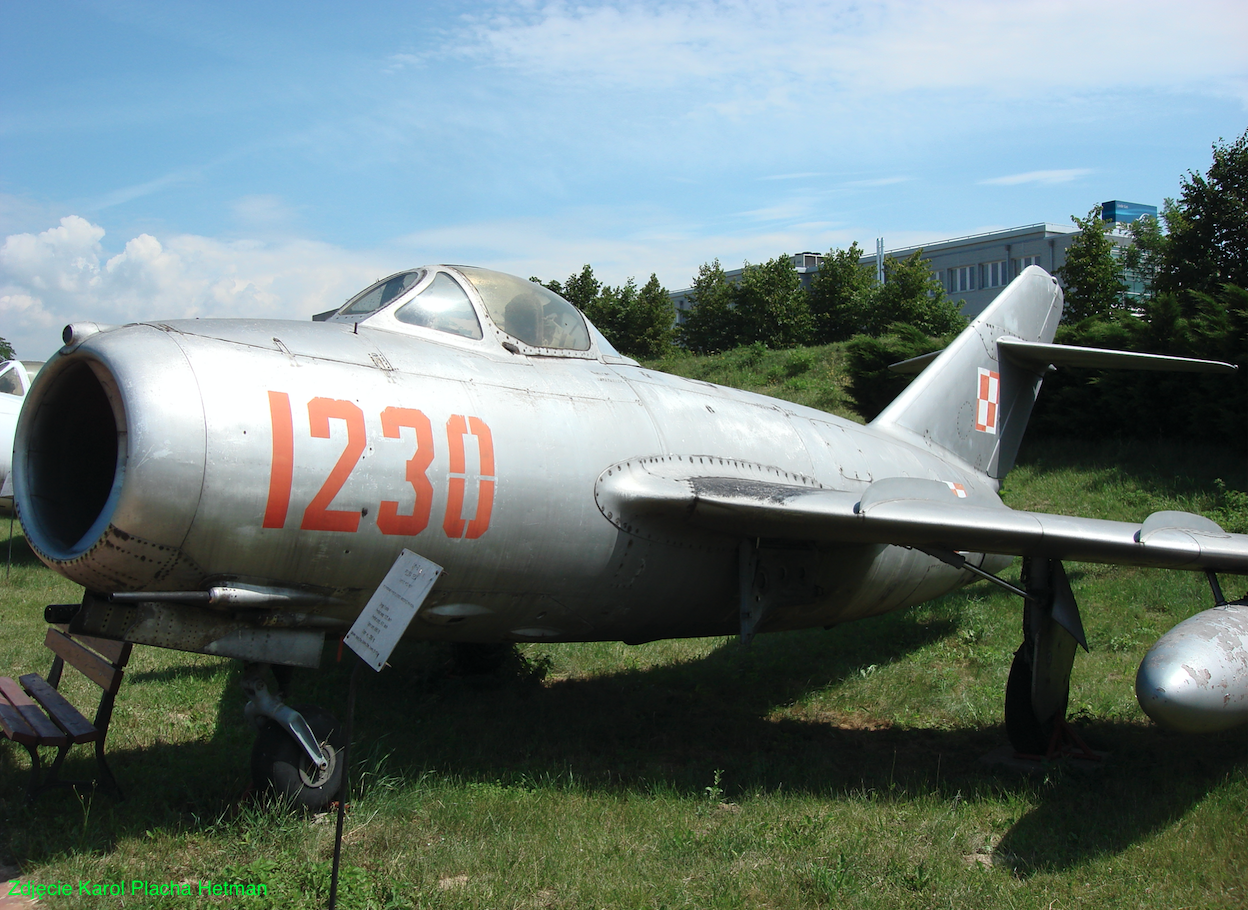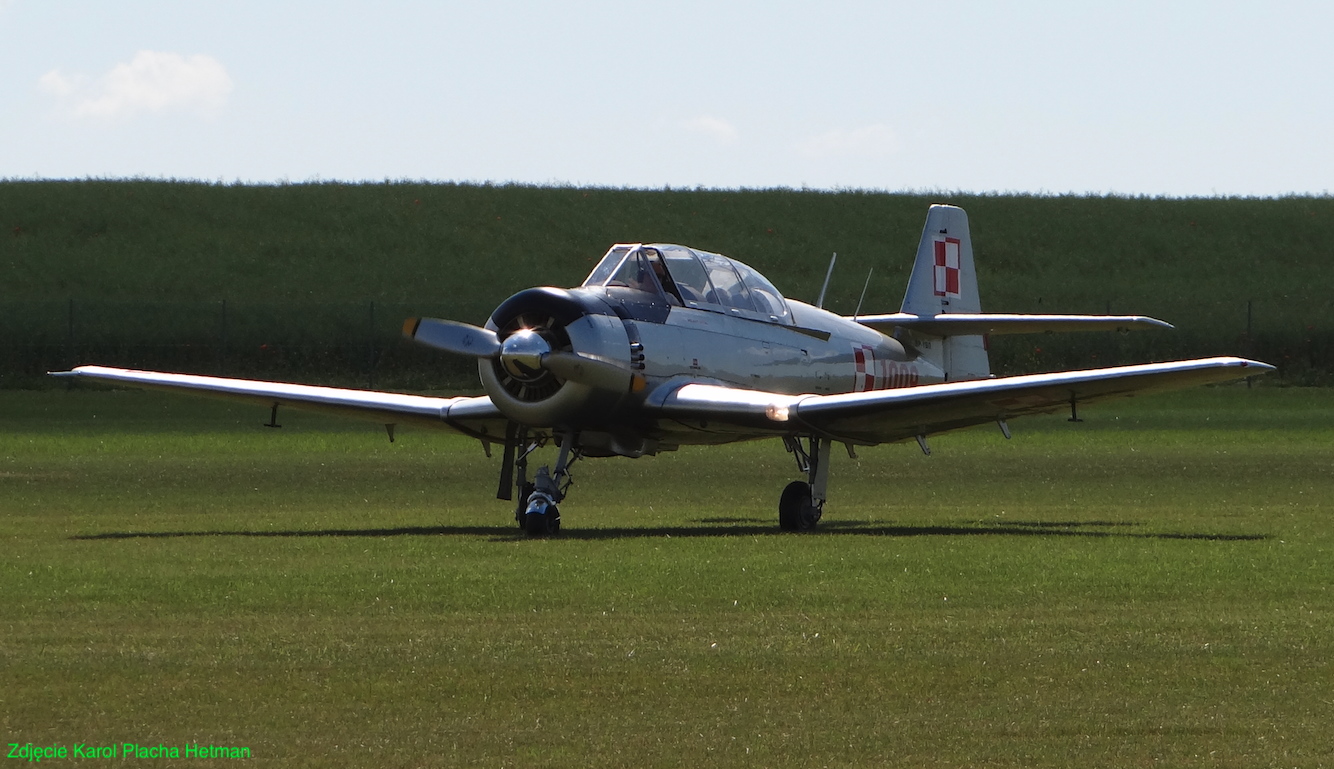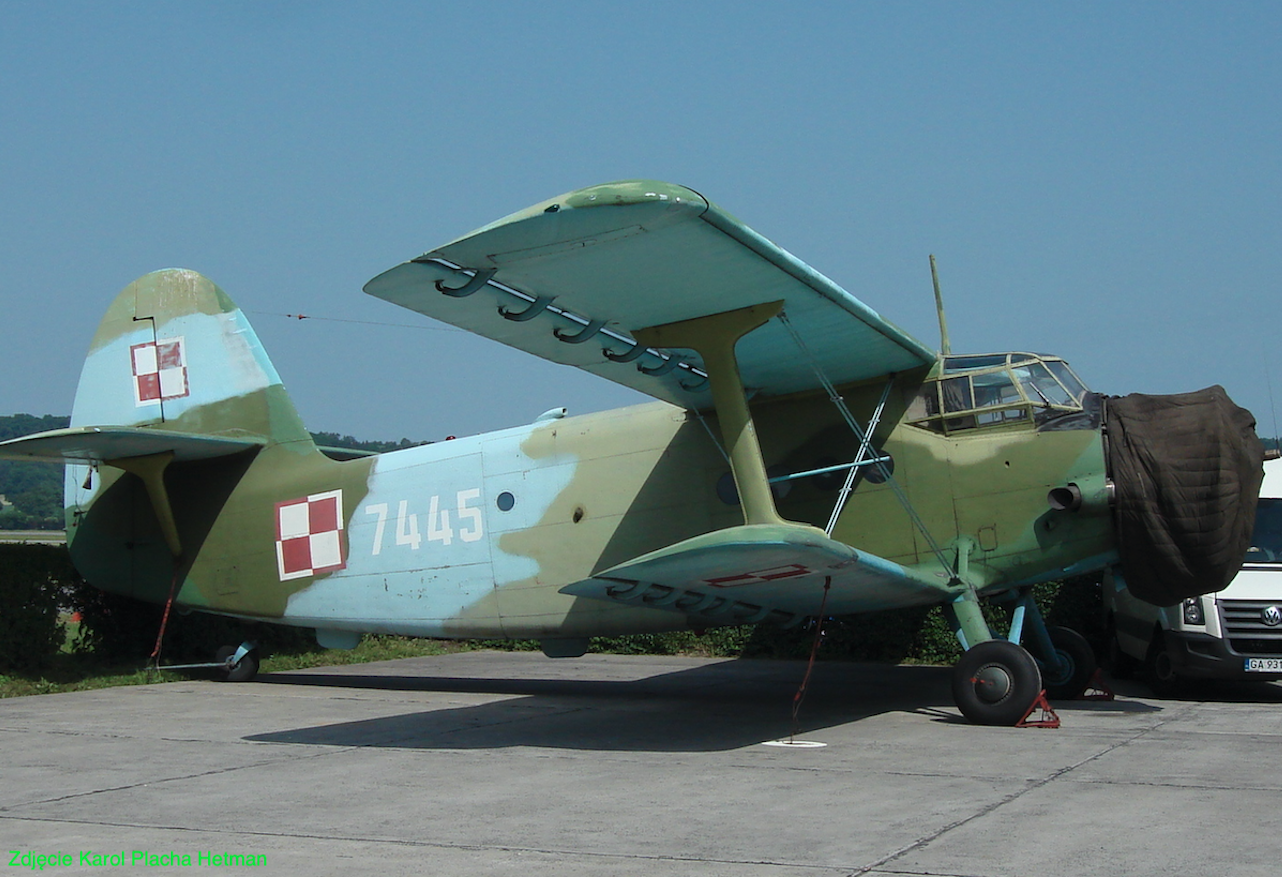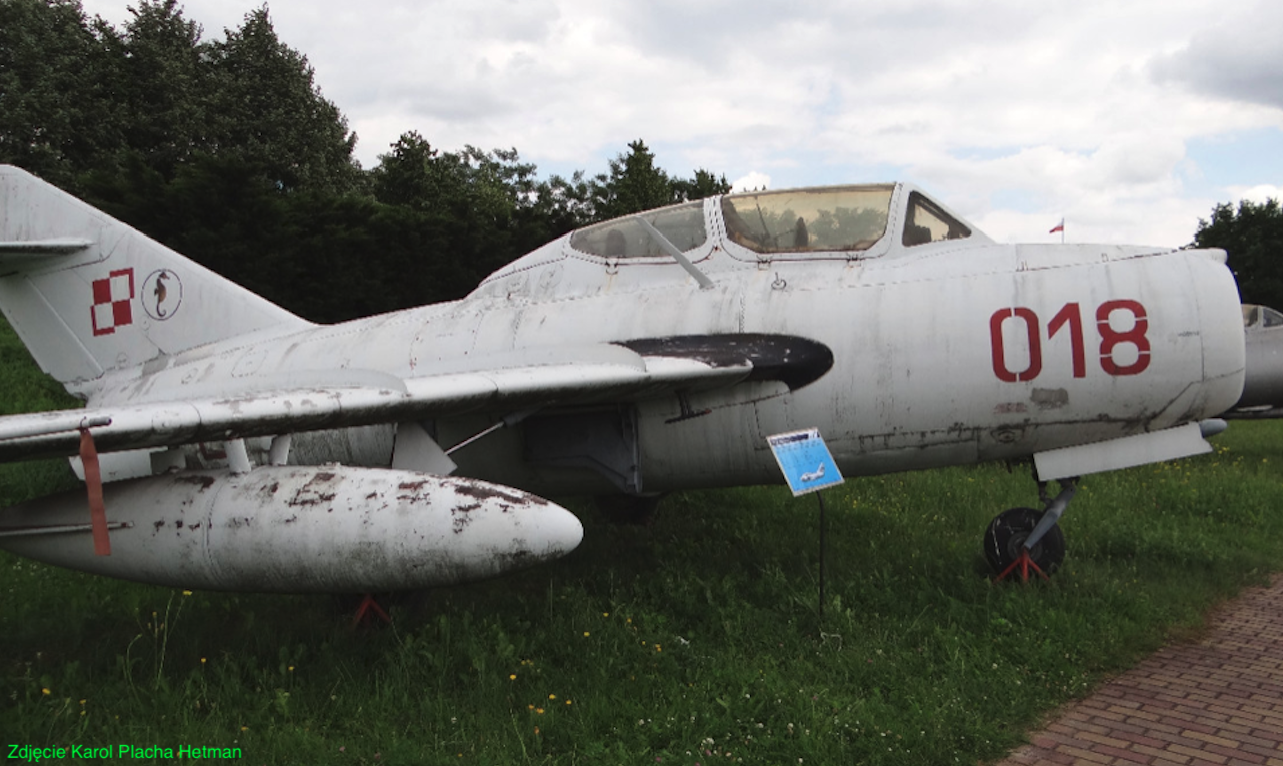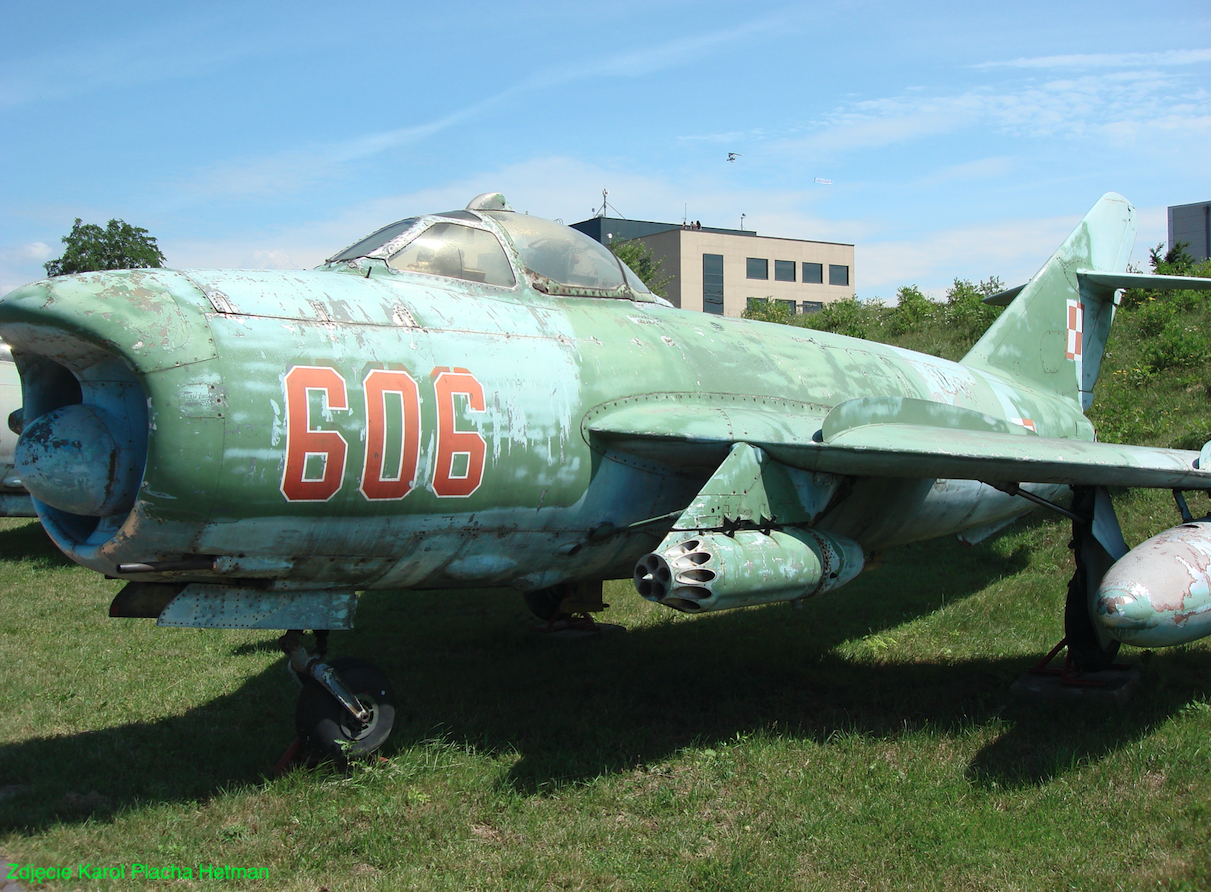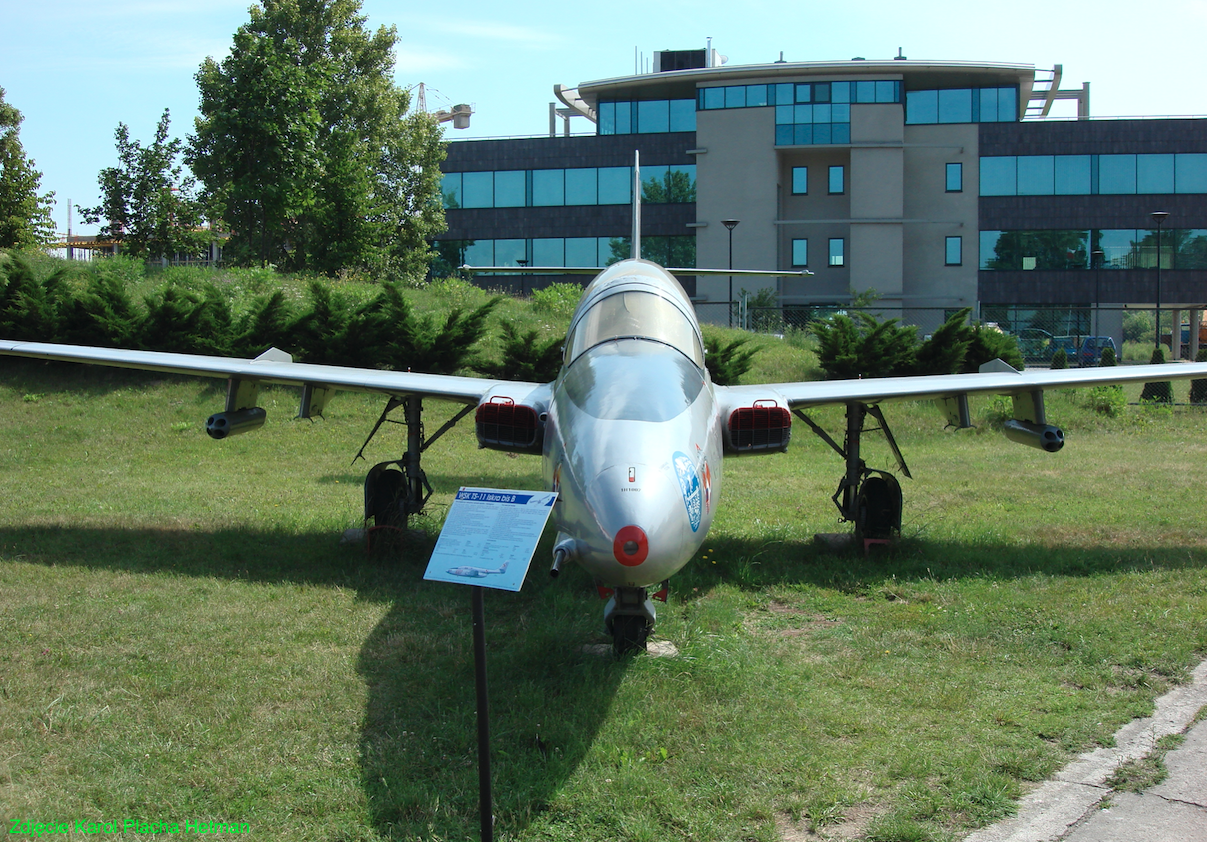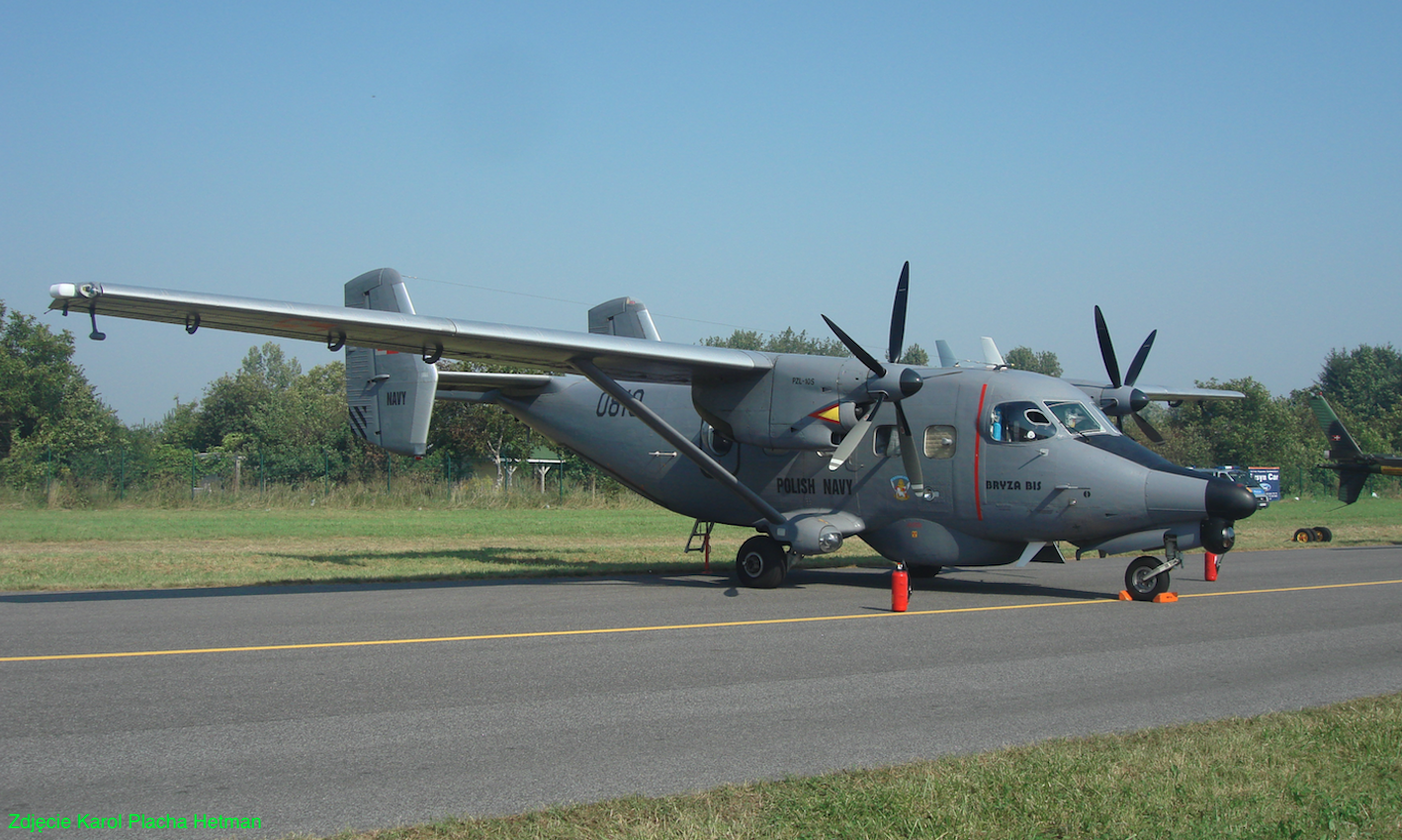Siemirowice 2010-06-30
Lotnisko Siemirowice.
Współrzędne geograficzne: 54.416N 17.765E. Elewacja 505 ft.
Lotnisko Siemirowice leży na Ziemi Lęborskiej. Ziemia Lęborska powróciła do Polski w 1945 roku i została przyłączona do Województwa Gdańskiego. W 1975 roku Lębork włączono do nowo utworzonego Województwa Słupskiego, a w 1999 roku, ponownie Ziemia Lęborska powróciła pod opiekę Gdańska w obszarze Województwa Pomorskiego. Z Lotniska w Siemirowicach do Lęborka jest 20 km, do Gdańska jest 72 km, do Bydgoszczy jest 177 km, a do Warszawy 412 km.
Historia Lotniska Siemirowice.
Lotnisko Siemirowice zlokalizowane jest w Województwie Pomorskim, Powiecie Lęborskim, Gminie Cewice. Inne stosowane nazwy; Lotnisko Cewice, Lotnisko Łebunia.
Lotnisko Siemirowice jest typowo Polskim Lotniskiem Wojskowym. Lotnisko zostało zbudowane w okresie 1950-1956, kiedy to w Polsce zbudowano prawie 40 lotnisk wojskowych. Lotnisko Siemirowice należało i należy do lotnisk podporządkowanych Polskiej Marynarce Wojennej. Decyzja o jego budowie zapadła z początkiem 50-lat XX wieku. Powstało ono jakby w zamian za likwidowane Lotnisko Gdańsk Wrzeszcz, które uniemożliwiało rozwój Trójmiasta. W tym czasie na Lotnisku Gdańsk Wrzeszcz stacjonował 30. Pułk Lotniczy Marynarki Wojennej, który był w przededniu dużych przemian.
Początkowo Lotnisko Siemirowice miało zająć wojsko sowieckie, które stacjonowało na terenie Polski, ale w wyniku rozmów polsko-radzieckich sowieci zajęli lotniska w zachodniej części Polski.
Pod lokalizację lotniska wybrano teren zalesiony, słabo zamieszkały. W pierwszych dokumentach pojawiała się nazwa Miejscowości Łebunia koło Lęborka. Później zaczęto używać nazwy Miejscowości Cewice, bo tutaj swoją siedzibę miały władze lokalne. Bloki mieszkalne osiedla oficerskiego (garnizonowego) zaczęto budować na terenie Miejscowości Siemirowice. Z tego też powodu, dla Lotniska, do dnia dzisiejszego, zamiennie stosowane są obie nazwy; Cewice, Siemirowice.
Projekt Lotniska uwzględniał wszystkie najnowsze trendy w budowie takich obiektów na świecie. Lotnisko zostało zaprojektowane dla bazowania jednostki lotniczej w sile pułku lotniczego, wraz z batalionem obsługi lotniska i dywizjonem ślepego lądowania. Do budowy Lotniska przystąpiono z początkiem 1953 roku. Jedną z pierwszych inwestycji była bocznica kolejowa, którą dostarczono praktycznie wszystkie materiały budowlane. Tempo prac było duże, a jednostka budowlana miała już spore doświadczenie we wznoszeniu podobnych obiektów. W 1955 roku, gotowa była już droga startowa (RWY), o wymiarach 2 000 m x 60 m, drogi kołowania i 20 indywidualnych stanowisk postojowych dla samolotów. Przed przybyciem pierwszego gospodarza gotowe były; MPS, magazyn techniczny, akumulatornia, kompresornia.
Kolej na Lotnisko Siemirowice.
Kolej do Lęborka została uruchomiona 1870 roku. Kolej połączyła Lębork z Gdańskiem i Stargardem Szczecińskim (linia kolejowa Nr 202). Natomiast kolej do Bytowa została uruchomiona w 1884 roku. Zarówno Lębork jak i Bytów stały się stacjami węzłowymi. W 1902 roku, Lębork i Bytów zostały połączone linią kolejową Nr 237. Linia Nr 237 miała długość 55 km. Przebiegała przez miejscowości: Lębork, Lębork Dretowo, Osowo Lęborskie, Maszewo Lęborskie, Cewice, Kamieniec, Oskowo, Kostroga, Czarna Dąbrówka, Jerzkowice, Jasień, Soszyca, Pomysk, Bytów. Linia Nr 237 miała znaczenie lokalne i została zbudowana jako jednotorowa, o prędkości maksymalnej do 60 km/h i nigdy nie była zelektryfikowana. Szlak był stosunkowo kręty, bo trzeba było pokonywać nawet 150 metrowe różnice wysokości. Dlatego też szlak miał liczne wiadukty i mosty, o konstrukcji ceglanej lub betonowej. Szlak przebiegał przez lasy, liczne wzgórza i wąwozy, przez co trasa była bardzo malownicza. Dopiero od Jerzkowic w kierunku Bytowa teren był łatwiejszy do pokonania. Łuki torowiska były bardziej łagodne. Warto wspomnieć, że w miejscowości Maszewo Lęborskie, była bocznica kolejowa, która wiodła na teren tamtejszej fabryki.
W marcu 1945 roku, Ziemia Lęborska została zajęta przez wojska CCCP i rozpoczął się okres grabieży, gwałtów i niszczenia. Linia kolejowa Nr 237 Lębork – Bytów została rozebrana przez moskali. Szyny kolejowe i inne urządzenia zostały wywiezione do CCCP. Niektóre wiadukty i mosty wysadzono w powietrze. Identyczny los spotkał linię kolejową Bytów – Miastko. Warto wspomnieć, że po byłych torowiskach samorzutnie powstały drogi gruntowe. W 1947 roku, odbudowano fragment szlaku kolejowego Nr 237, na odcinku Lębork – Kamieniec, o długości 17 km. Odbudowa była związana z planowaną budową lotniska, na potrzeby wojsk sowieckich, stacjonujących w Polsce. Ze stacji Kamieniec poprowadzono bocznicę kolejową bezpośrednio na budowane lotnisko. Długość bocznicy kolejowej wyniosła około 1 500 m. Aby wjechać na bocznicę, pociąg po przyjeździe z Lęborka do stacji Kamieniec musi zmienić kierunek jazdy i po łuku torów w prawo skierować się na wschód. Na stacji Kamieniec, od strony południowej, zachowały się dwa tory. Jeden zakończony betonowym kozłem oporowym. Drugi był torem szlakowym i kończy się przed drogą kołową. Około 1950 roku, na odbudowanym szlaku uruchomiono ruch pasażerski, bo rozwijający się Lębork potrzebował pracowników. Ruch pasażerski został wstrzymany w 1979 roku, a pasażerów przejęła komunikacja autobusowa. Pociągi towarowe kursowały do 2004 roku. W 2014 roku, szlak Nr 237 na odcinku Lębork – Maszewo Lęborskie (11 km) został zmodernizowany. Koszt inwestycji wyniósł 9,5 milionów złotych.
Obecnie (2021 rok) na istniejącym szlaku Nr 237 odbywa się tylko ruch towarowy, o znaczeniu państwowym, bo zapewnia transport na wojskowe lotnisko i do bazy pancernej w osiedlu Lębork Dretowo. Na zlikwidowanym szlaku, wysadzone w 1945 roku, wiadukty i mosty zachowały się jako trwałe ruiny i są godne zwiedzenia. Na stacjach kolejowych zachowały się także budynki dworcowe i magazynowe, zbudowane z czerwonej cegły lub muru pruskiego. Wszystkie przykryte są czerwoną dachówką. Na ścianach można znaleść germańskie napisy nazw stacji. Większość z tych budynków jest zamieszkała. Po rozebranym torowisku można znaleść spróchniałe podkłady kolejowe, słupki kilometrowe i nieliczne mosty. Od strony Bytowa tor był prawie prosty i przebiegał w sztucznym wąwozie oraz dalej na nasypie.
Drogi na Lotnisko Siemirowice.
W pobliżu lotniska, od strony wschodniej, przebiega Droga Wojewódzka Nr 214, która łączy Łebę z Warlubiem. Droga ma długość 170 km i przebiega przez Gminę Cewice, gdzie jest lotnisko. Warto wspomnieć, że droga ta od Warlubia do Głuchego koło Skórcza, na długości 28 km, była zbudowana w 20-leciu międzywojennym. Droga ta była pierwszą częścią polskiej autostrady z Warszawy do Gdyni. Autostrada ta został zaprojektowana przez włoskiego inżyniera Piero Purricellego, który projektował włoskie autostrady. Autostrada miała omijać tereny niemieckie i Wolne Miasto Gdańsk, podobnie jest linia kolejowa Nr 201. Autostrada była prowadzona długimi prostymi odcinkami, omijając wsie. Ten pierwszy odcinek od Warlubia do Głuchego (28 km) został zbudowany w okresie 1936-1939. Dalszą budowę przerwali germańcy napadając na Polskę.
Wracając do dojazdu na lotnisko, to doprowadza do lotniska Droga Wojewódzka Nr 212, która ma długość 116 km. Patrząc od Lęborka w kierunku południowym, od Drogi Wojewódzkiej Nr 214, w miejscowości Osowo Lęborskie, rozpoczyna się droga Nr 212, w kierunku południowo-zachodnim. Droga Wojewódzka Nr 212 łączy: Lębork-Bytów-Chojnice-Człuchów-Bydgoszcz. Tą drogą możemy dojechać na inne byłe wojskowe Lotnisko Konarzyny.
Lotnisko Siemirowice. 50-lata.
Pierwszą jednostką wojskową, która na wiele lat zadomowiła się na Lotnisku Siemirowice, była utworzona w 1955 roku, 15. Samodzielna Eskadra Lotnictwa Rozpoznawczego MW. Rzut powietrzny 15 SELR przebazowano na Lotnisko Siemirowice w dniu 1 października 1956 roku. W 1956 roku, na Lotnisku bazowały; 2 Ił-28, 3 Ił-28 R, 1 UIł-28 oraz łącznikowy Po-2. Systematycznie powstawały kolejne służby, a dla nich obiekty; dział meteo, obróbki filmów, łączności.
Jednocześnie z chwilą powołania do istnienia 15. SELR MW szykowały się zmiany w pozostałej części 30. PL MW. Pułk jeszcze szkolił się na samolotach typu Jak-9 i Jak-11, ale już zapadły decyzje o przezbrojeniu w samoloty z napędem turboodrzutowym. W dniu 27.07.1957 roku, ukazało się Zarządzenie Nr 0137/Org. Szefa Sztabu Generalnego Wojska Polskiego, o przeformowaniu 30. PL MW w 30. Pułk Lotnictwa Szturmowego Marynarki Wojennej. Za tym zarządzeniem, w dniu 16.08.1957 roku, ukazał się Rozkaz Dowódcy MW w tej sprawie. Na miejsce stacjonowania wyznaczono także Lotnisko Siemirowice. W dniu 10.08.1957 roku, Pułk samochodami został przebazowany do Siemirowic. Samoloty Jak-9 zostały wycofane ze stanu i przekazane do Dęblina, a podstawowym samolotem Pułku zostały samoloty Lim-2. Pierwsze egzemplarze wylądowały w Siemirowicach w sierpniu 1957 roku. W tym czasie większość pilotów przechodzi przeszkolenie na nowy typ samolotów w Dęblinie, a personel techniczny szkolił się w Zamościu. Pułk do dyspozycji miał nadal samoloty Jak-11.
Aby uzupełnić historię pierwszych lat Lotniska Siemirowice należy podać jeszcze kilka historycznych faktów – W dniu 12.11.1949 roku, Minister Obrony Narodowej nakazał do dnia 25.03.1950 roku, sformować 50. Batalion Obsługi Lotnisk Marynarki Wojennej w Słupsku. W 1951 roku, na podstawie Rozkazu Ministra Obrony Narodowej, dowódca Marynarki Wojennej polecił przeniesienie 50. Batalionu Obsługi Lotnisk MW ze Słupska do Gdyni Babich Dołów. Lecz już w dniu 15.07.1952 roku, jednostkę przebazowano na lotnisko w Gdańsku Wrzeszczu i podporządkowano bezpośrednio pod Dowództwo Lotnictwa MW. Ponieważ zdecydowano o likwidacji Lotniska Gdańsk Wrzeszcz, w dniu 13.05.1957 roku, dowódca Marynarki Wojennej polecił do dnia 10.08.1957 roku, przebazowanie 50. Batalionu Obsługi Lotnisk do Garnizonu Siemirowice.
60-lata.
Po trzech latach, w grudniu 1960 roku, na mocy zarządzenia Szefa Sztabu Generalnego WP 30. Pułk Lotnictwa Szturmowego MW i 50. Batalion Obsługi Lotnisk MW przeformowano w 30. Pułk Lotnictwa Myśliwsko – Szturmowego.
Działo to się na podstawie ogólnej tendencji w Lotnictwie Polskim, a podstawowym powodem był brak specjalistycznego samolotu szturmowego. Podajmy, iż rosjanie w 50-tych latach XX wieku, nie wprowadzili do uzbrojenia, żadnego samolotu szturmowego, a skupili się wyłącznie na myśliwcach przechwytujących i bombowcach dalekiego zasięgu. W Polskim Przemyśle Lotniczy, konstruktorzy analizując Zachodnie wymogi, dotyczące zdolności działania samolotów szturmowych, doszli do wniosku, iż samolot Lim-5 po odpowiednich modyfikacjach, jest w stanie pełnić rolę samolotu szturmowego. Takie prace podjęto. W ich efekcie powstał samolot oznaczony Lim-5 M. Wyprodukowano partię tych samolotów i w 1960 roku, skierowano do kilku jednostek wojskowych, celem próbnej eksploatacji.
Kilka samolotów Lim-5 M trafiło także do Siemirowic. Nie wiemy, jak konkretnie wyglądała eksploatacja tych maszyn w 30. PLM-Sz w Siemirowicach. Wiadomo, iż pierwsze tygodnie eksploatacji samolotów Lim-5 M w Polskim Lotnictwie Wojskowym nie wypadły pozytywnie. Doszło do kilku awarii i katastrof. Samoloty zaczęto eksploatować ze znacznymi ograniczeniami, a po kilku miesiącach samoloty zwrócono wytwórcy, celem przeprowadzenia modernizacji. Więcej na ten temat jest w innych artykułach.
W lutym 1963 roku, na wyposażenie 30. PLM-Sz trafiły pierwsze samoloty Polskiej produkcji, szkolno-treningowe TS-8 Bies. Samoloty te znacznie poprawiły proces szkolenia młodych pilotów w jednostce, a doświadczonym pilotom pozwoliły na utrwalenie zdobytych nawyków.
W dniu 30 stycznia 1964 roku, na Lotnisku Siemirowice wylądowały samoloty Lim-6 bis. Ostatni samolot dostarczono z początkiem marca 1964 roku. Łącznie na stan przyjęto 23 egzemplarze. Wszystkie samoloty Lim-6 bis weszły w na stan 30. PLM-Sz MW, zastępując większość samolotów typu Lim-2. Samoloty Lim-6 bis to była kontynuacja procesu modernizacji samolotów Lim-5 M. Nowy samolot otrzymał mniej nowatorskich rozwiązań, niż Lim-5 M, ale znacznie lepsze uzbrojenie, w postaci niekierowanych pocisków rakietowych. Więcej na ten temat w innych artykułach. Samoloty Lim-6 bis na wiele lat stały się w Polskim Lotnictwie Wojskowym podstawowym samolotem szturmowym. Udanym i lubianym przez pilotów i techników. Oczywiście także w Siemirowicach.
Pierwszy samolot An-2 pojawił się w Siemirowicach w styczniu 1965 roku. Wcześniej użytkowała go 18. Eskadra Lotnictwa Łącznikowego w Gdyni Babich-Dołach. W dniu 22.12.1965 roku, z 30. Pułku Lotnictwa Myśliwsko – Szturmowego został wydzielono 50. Batalion Zaopatrzenia.
Kolejna reorganizacja w maju 1967 roku, zmieniła numerację pułku z 30. na 7. PLM-Sz. W 1966 roku, pojawiła się potrzeba reorganizacji 15. Samodzielnej Eskadry Lotnictwa Rozpoznawczego. Dotychczasowy sprzęt stopniowo się wykruszał, a na zastąpienie rozpoznawczych Ił-28 R nowoczesnymi samolotami nie zanosiło się. W tej sytuacji przyjęto rozwiązanie doraźne. Wprowadzono na uzbrojenie, z początkiem 1967 roku, samoloty rozpoznania taktycznego z rodziny SB Lim-2. W konsekwencji jednostka została przemianowana na 15. Eskadrę Lotnictwa Rozpoznawczego MW. Eskadra rozrosła się ilościowo, ale nie było postępu jakościowego. Powołano do życia trzy klucze lotnicze na samolotach SB Lim-2 Art (SB Lim-2 A) Pierwsze „Arty" przybyły do Siemirowic w październiku 1967 roku.
70-lata.
W miarę upływu czasu, używane przez Polskie Lotnictwo Myśliwskie myśliwce przechwytujące typu Lim-5 P (te z celownikami radiolokacyjnymi) przestały spełniać swoją rolę. Ponieważ dysponowały jeszcze długim resursem płatowców postanowiono przebudować je na wersje myśliwsko-szturmowe. Z samolotów usunięto SR. Dla zachowania równowagi przeniesiono akumulator do przodu i dodano balast. Zamontowano aparat fotograficzny AFA-39. Dodano dodatkowe węzły uzbrojenia. Nie montowano spadochronu hamującego. Prace prowadzono w LZR-2 w Bydgoszczy. Samolot ostatecznie nazwano Lim-6 M lub Lim-6 MR. Pierwszym tak przebudowanym samolotem w 1971 roku, był 1D 06-02. W latach 1972-1978, przebudowano około 60 maszyn Lim-5 P do standardu Lim-6 MR. Samoloty te jako pierwsze w Polskim Lotnictwie Wojskowym otrzymały malowanie zwane kamuflażem. Z początkiem 70-lat maszyny te trafiły także do 7. PLM-Sz. Uzupełniły stan samolotów Lim-6 bis.
W kwietniu 1977 roku, zakończono szkolenie na samolotach TS-8 Bies, a w maju 1977 roku, przyleciały do Siemirowic pierwsze samoloty PZL TS-11 Iskra.
W dniu 1.10.1979 roku, zakończyły służbę samoloty Ił-28. Lotnictwo Marynarki Wojennej jako ostatnie w Polsce zakończyło eksploatację tego typu samolotów. W dniu 15.06.1982 roku, uroczyście zakończono eksploatację i wycofano z uzbrojenia ostatnie w Lotnictwie Marynarki Wojennej samoloty typu Lim-6 bis/MR.
80-lata.
W listopadzie 1982 roku, zgodnie z tendencją, 7. PLM-Sz została przemianowana na 7. Pułk Lotnictwa Myśliwsko-Bombowego i czekała na nowe samoloty typu Su-22. Jednak te samoloty nigdy na stan jednostki w Siemirowicach nie trafiły. Brak nowych samolotów bojowych wymusiła kolejne zmiany w jednostkach bazujących w Siemirowicach. W dniu 1.07.1988 roku, została rozformowana 15. Samodzielna Eskadra Rozpoznawcza MW. W połowie 80-tych lat, posiadała ona na wyposażeniu 10 samolotów SB Lim-2 A i 2 samoloty SB Lim-2. Samoloty te kończyły już swoje resursy. Zostały przejęte przez 7. Pułk.
Pułk 7. PLM-B został przemianowany na 7. Pułk Lotnictwa Specjalnego, z dwiema eskadrami samolotów w Siemirowicach i dwiema eskadrami śmigłowców w Darłowie.
Podstawowym samolotem w Pułku został szkolno-treningowy TS-11 Iskra. Uzupełnieniem były poczciwe transportowe An-2. W tym czasie Polski Przemysł Lotniczy produkował już seryjnie, na potrzeby CCCP, samoloty An-28. Nieduży samolot transportowy o modnej w tym czasie właściwości; skróconego startu i lądowania. Polskie Lotnictwo Wojskowe od końca 80-tych lat wykazywało zainteresowanie nowym samolotem z Mielca. Od 1987 roku, w PZL Mielec pracowano nad przystosowaniem An-28 do wymogów Polskiego Wojska. Wprowadzono wiele modyfikacji. Wszystko to doprowadziło do badań kwalifikacyjnych zakończonych pozytywnym wynikiem.
Pierwszym odbiorcą wojskowym samolotów PZL An-28/M-28 była Marynarka Wojenna, która otrzymała wersje transportowo-pasażerska An-28 TD. Samoloty zakupiono w 1988 roku, i były to dwie maszyny nr 1AJ 004-04 nb 0404 i nr 1AJ 004-05 nb 0405. Samoloty te bazowały zarówno na Lotnisku Siemirowice jak i na Lotnisku Babie Doły.
Zgodnie z zarządzeniem Szefa Sztabu Generalnego WP z grudnia 1990 roku, w dniu 31.03.1991 roku, rozformowano 50. Batalion Zaopatrzenia. Od tej chwili stał się on pododdziałem sformowanego 7. Pułku Lotnictwa Specjalnego MW.
Wobec braku perspektyw zakupu nowych samolotów bojowo-rozpoznawczych dla Marynarki Wojennej postanowiono do tych zadań zaadoptować Polski samolot TS-11 Iskra, który oznaczono TS-11 Iskra R. Samolot powstał na bazie TS-11 bis DF. To prowizoryczne rozwiązanie przetrwało aż 11 lat. Nie budowano nowych egzemplarzy samolotów tylko udoskonalono istniejące. Samolot otrzymał radar pogodowy RDS-81 amerykańskiej produkcji. Jego obsługę prowadzi lotnik w drugiej kabinie. Maszyna otrzymała także system nawigacji satelitarnej GPS. Wersja ta wiąże się nierozerwalnie z Lotnictwem Morskim. To na potrzeby lotników morskich powstało 6 TS-11 Iskra R o numerach 19-09, 19-10, 19-13, 19-17, 19-18, 19-19. Samoloty te trafiły do 3. Dywizjonu Lotniczego w Siemirowicach, gdzie służyły przez jedenaście lat. Dywizjon ten posiadał na uzbrojeniu także typowe TS-11 bis DF o numerach 14-10, 14-11, 14-13, 17-16, 17-22, 18-02, 18-03, 18-05, 20-11, 20-12, 20-13, czyli 11 maszyn. Wszystkie samoloty używane w Siemirowicach posiadały kamuflaż, a od 1999 roku, po przystąpieniu Polski do NATO, dodano biały napis NAVY.
Pozytywne opinie o samolocie M-28 (An-28) spowodowały, iż Marynarka Wojenna złożyła zamówienie na opracowanie wersji patrolowej tego samolotu. Dowództwo Lotnictwa MW określiło w 1989 roku, wymagania na samolot patrolowo-ratowniczy w celu zastąpienia starzejących się PZL An-2 M. Przewaga Polskiej konstrukcji nad analogicznymi Zachodnimi, (ale zdecydowanie większymi i cięższymi), była zdecydowana. W PZL Mielec opracowano samolot w wersji patrolowej PZL An-28 B1R Bryza-1R nr 1 AJGP 01-01. Maszyna pochodziła z istniejącego samolotu An-28 ósmej serii produkcyjnej. Prototyp nowego samolotu oblatano w 1992 roku. Pod kadłubem samolotu w gondoli zamontowano stację radiolokacyjną SRN-441XA.
Już w 1993 roku, samolot otrzymał znacznie zmodyfikowany radar ARS-100. Wyposażony został w nową antenę, choć ze starszym wskaźnikiem zobrazowania z radarów morskich serii SRN-400. Pierwszy samolot nazwany M-28 RM ze SR ARS-100 został przekazany do prób w MW w październiku 1994 roku. Na tym nie koniec modyfikacji. W 1997 roku, opracowano całkiem nowy system radiolokacyjny oznaczony ARS-400. SR ARS-400 służy do wykrywania obiektów na powierzchni morza, wykrywania linii brzegowej, ochrony przed przemytem, ochrony rybołówstwa, zjawisk pogodowych, wykrywania zanieczyszczeń, zadań ratowniczych, namierzania urządzeń odzewowych. Radar może śledzić wybrane cele automatycznie lub ręcznie. Dane automatycznie przekazuje się do systemu dowodzenia Łeba-2. Radar ma płaską antenę z układem stabilizacji wiązki. SR pracuje w paśmie 9,2-9,5 GHz. Układ pracy jest wielokanałowy – śledzi cele nawodne, mapuje teren, monitoruje zjawiska atmosferyczne i zanieczyszczenia. Śledzi do 100 celów jednocześnie w odległości ponad 100 km. W skład innego wyposażenia wchodzą; stacja radiolokacyjna nawigacyjna sprzężona z systemem precyzyjnej nawigacji, automatyczny pilot, aparat fotograficzny, radionamiernik ratowniczy Cheliton, system ŁS-10 wyjścia i wejścia połączenia z systemem dowodzenia Łeba-2, dwa węzły do podwieszenia 100 kg bomb oświetlających, tratwy ratunkowe. Po zakończeniu prób z SR ARS-400, wojsko odebrało 7 samolotów z tym systemem. Zbudowano dla MW 7 maszyn pochodzących z 10 i 11 serii produkcyjnej. Nb 1006, 1008, 1017, 1022, 1114, 1115, 1116.
Lata 1994–1995, były okresem przebudowy struktur lotnictwa Marynarki Wojennej. Na podstawie zarządzenia Szefa Sztabu Generalnego WP i Rozkazu dowódcy Marynarki Wojennej z dnia 28.08.1994 roku, rozpoczęto proces formowania Brygady Lotnictwa Marynarki Wojennej. Z dotychczasowych jednostek utworzono trzy Dywizjony Lotnicze Marynarki Wojennej; 1. Pucki DL – MW w Babich Dołach (głównie z myśliwcami MiG-21 bis), 2. DL – MW w Darłowie (głównie ze śmigłowcami do ZOP. Powstał z 40 Eskadry Śmigłowców Zwalczania Okrętów Podwodnych i Ratownictwa w Darłowie). Dodatkowo 4 Batalion Zabezpieczenia. 3. DL – MW w Siemirowicach (z samolotami TS-11 R i PZL M-28). Powstał w dniu 30.12.1995 roku, w wyniku rozformowania 7. Pułk Lotnictwa Specjalnego w Siemirowicach i powołania 3. Dywizjonu Lotniczego oraz 5. Batalionu Zabezpieczenia. W dniu 2.01.1996 roku, podczas uroczystej zbiórki, pożegnano sztandar 7 Pułku.
W skład 3. Dywizjonu Lotniczego weszły; Eskadra Rozpoznawcza z samolotami TS-11 Iskra R i TS-11 Iskra. Eskadra Patrolowo-Rozpoznawcza z samolotami An-2, M-28 Bryza. Samoloty TS-11 otrzymały nowy kamuflaż, nowe godła i białe napisy NAVY. Organizacyjnie 3. DL podporządkowano dowódcy Brygady Lotnictwa Marynarki Wojennej.
W dniu 12.10.1996 roku, 5. Batalion Zabezpieczenia w Siemirowicach otrzymał nowy sztandar.
W 1997 roku, sztandar otrzymał także 3. Dywizjon Lotniczy. W dniu 27.08.1997 roku, odbyło się uroczyste wręczenie sztandaru ufundowanego przez społeczeństwo Ziemi Kaszubskiej. Jednocześnie decyzją Ministra Obrony Narodowej Nr 155/MON z dnia 2.09.1997 roku, Dywizjon otrzymał nazwę „Kaszubski”. Dowódca Marynarki Wojennej admirał Ryszard Łukasik wręczył sztandar dowódcy Dywizjonu komandorowi podporucznikowi dyplomowanemu pilotowi Mirosławowi Jankowskiemu. Sztandar ufundowało społeczeństwo kaszubskich gmin Bytów i Sierakowiec.
Jednostka 3. Dywizjon Lotniczy był samodzielną jednostką bojową Marynarki Wojennej przeznaczoną do: Prowadzenia rozpoznania operacyjno-taktycznego obiektów nawodnych. Naprowadzania na wykryte obiekty sił uderzeniowych MW. Wykonywania zadań transportowo-łącznikowych. Wykonywania zadań ratowniczych na lądzie i morzu. W dniu 1.07.1997 roku, na stanie 3. Kaszubskiego Dywizjonu Lotniczego MW znajdowały się; 6 TS-11 R Iskra bis DF, 8 TS-11 Iskra bis DF, 2 An-28 RM przemianowane na M-28, 5 An-2.
Pierwsza dekada XX wieku.
Przystąpienie Rzeczypospolitej Polskiej do struktur NATO w 1999 roku, wywołało kolejne zmiany organizacyjne w całym Polskim Lotnictwie Wojskowym. Systematycznie dążono do przyjęcia systemu amerykańskiego, czyli lotnisko jako baza było jednym podmiotem, a komponent lotniczy (statki powietrzne i piloci) drugim podmiotem. Stosunkowo szybko okazało się, iż ten system nie sprawdza się przy tak małym ilościowo lotnictwie, jakim jest Lotnictwo Polski. Lecz pierwsze lata nowego stulecia, to okres tworzenia baz i osobnych eskadr.
Rozkazem dowódcy Marynarki Wojennej z dnia 28.04.2002 roku, z dniem 1.01.2003 roku, na bazie rozformowanego 4. i 5. Batalionu Zabezpieczenia, sformowano 44. Bazę Lotniczą Marynarki Wojennej. Dla upamiętnienia daty wydania rozkazu dowódcy Marynarki Wojennej o przebazowaniu 50. Batalionu Obsługi Lotnisk MW do Garnizonu Siemirowice, święto jednostki obchodzono w dniu 13 maja.
Głównym zadaniem 44. Bazy Lotniczej MW było zabezpieczenie szkolenia 29. i 30. Eskadry Lotniczej na lotniskach w Siemirowicach i Darłowie oraz zabezpieczenie samolotów i śmigłowców 28. Eskadry Lotniczej, Sił Powietrznych, Wojsk Lądowych i sił sojuszniczych czasowo bazujących na podległych lotniskach. Baza odpowiada za wykonywanie obsług technicznych oraz naprawy bieżące samolotów i śmigłowców, zabezpieczenie środków bojowych, materiałów do obsługi statków powietrznych oraz stałe funkcjonowanie systemów łączności. Do zadań jednostki należało również kierowanie ruchem lotniczym w rejonie lotnisk oraz utrzymywanie ich w stałej sprawności eksploatacyjnej. W strukturze bazy znajdował się Dywizjon Dowodzenia, Dywizjon Zabezpieczenia, Dywizjon Techniczny, Wojskowy Port Lotniczy Cewice (Siemirowice) oraz Komenda Lotniska nr 2 z Wojskowym Portem Lotniczym w Darłowie.
Jednostka 30. Kaszubska Eskadra Lotnicza Marynarki Wojennej powstała w wyniku reorganizacji jednostek gdyńskiej Brygady Lotnictwa MW w 2003 roku. Sformowano ją na bazie 3. Kaszubskiego Dywizjonu Lotniczego, którego korzenie sięgają początków powojennego odtwarzania lotnictwa morskiego, a dokładniej eskadry lotniczej Marynarki Wojennej powstałej w październiku 1948 roku, w Wicku Morskim.
W dniu 1.01.2003 roku, 3. Dywizjon został przeformowany w 30. Eskadrę Lotniczą. W 2004 roku. Eskadra oficjalnie przejęła tradycje 304. Dywizjonu Ziemi Śląskiej im. ks. Józefa Poniatowskiego i stała się kontynuatorką bojowych tradycji Polskich lotników morskich z czasów II wojny światowej.
Jednostka 30. Eskadra Lotnicza jest jednostką całkowicie uzawodowioną, przeznaczoną do poszukiwania, wykrywania i śledzenia przeciwnika samodzielnie i we współpracy z okrętowymi grupami poszukująco-uderzeniowymi, naprowadzania na wykryte obiekty sił uderzeniowych MW i lotnictwa oraz wykonania zadań transportowo-łącznikowych. Ponadto we współpracy z Morskim Ratowniczym Centrum Koordynacyjnym w Gdyni podejmuje akcje ratownicze na lądzie i morzu.
Przemiany te nie były tylko czysto papierowe. Wiązały się także ze zmianami sprzętowymi. Po pierwsze, wycofano z Lotniska Siemirowice wszystkie samoloty TS-11 R Iskra. Przekazano je głównie do trzech Eskadr Lotnictwa Myśliwskiego; 3 ELM Krzesiny, 10 ELM Łask i 41 ELM Malbork. Stało się to w chwili gdy eskadry te zakończyły eksploatacje myśliwców typu MiG-21.
W tym miejscu jeszcze jedna uwaga. Po wycofaniu samolotów TS-11 Iskra z Marynarki Wojennej pozostała ona bez samolotów z napędem turboodrzutowym. Niezdolna do wykonania jakichkolwiek działań uderzeniowych. Dużo się w tym czasie mówiło na temat przystosowania do zadań morskich wszystkich do tej pory wyprodukowanych Polskich samolotów PZL I-22 Iryda. Niestety na planach się skończyło, a w 2008 roku, Rząd Rzeczypospolitej Polskiej (liberałów) wysłał te samoloty na złom. Tak więc, TS-11 Iskra to był łabędzi śpiew Polskiego Lotnictwa Marynarki Wojennej.
Ponownie jednostce przyznano nazwę wyróżniającą „Kaszubska”. Przyznana została decyzją nr 615/MON z dnia 27.12.2007 roku.
W dniu 5.09.2008 roku, po raz kolejny zorganizowano Dzień Otwarty połączony z obchodami święta 30. Kaszubskiej Eskadry Lotniczej. Dzień wcześniej (4.09.2008 rok) odbyła się uroczysta zbiórka, na której odczytano okolicznościowy rozkaz i wręczono wyróżnienia, nagrody i awanse. Po raz pierwszy załogi patrolowo – rozpoznawczych Bryz zaprezentowały swoje umiejętności podczas zawodów na celność zrzutu imitatora tratwy ratunkowej.
W 2008 roku, wykonano 24 loty patrolowo-rozpoznawcze oraz 15 lotów monitoringu ekologicznego. W 2008 roku, żołnierze eskadry brali udział m. in. w ćwiczeniach NOBEL MARINER, BALTOPS, ANAKONDA. Podczas 51. Konferencji Bezpieczeństwa Lotów Lotnictwa Sił Zbrojnych eskadra otrzymała z rąk Dowódcy Sił Powietrznych puchar za bezpieczne wykonywanie zadań w powietrzu. Szczególne osiągnięcia w wykonywaniu zadań służbowych w 2008 roku, były podstawą uhonorowania eskadry przez Ministra Obrony Narodowej „Znakiem Honorowym Sił Zbrojnych Rzeczypospolitej Polskiej”.
Eskadra wyposażona jest w samoloty patrolowo – rozpoznawcze An-28 B1R (M-28 BRYZA 1R) i samoloty monitoringu ekologicznego An-28 E. Załogi samolotów patrolowo – rozpoznawczych, wyposażonych w radar obserwacji obiektów nawodnych, patrolują wody Bałtyku, wykonują zadania rozpoznania okrętów i określenia charakteru ich działań. Załogi pełniące dyżury bojowe, dzięki wyposażeniu samolotu w urządzenie detekcji sygnałów z radiostacji ratowniczych i możliwości zrzutu tratwy ratowniczej wspierają krajowy system SAR. Mogą brać udział w akcjach poszukiwawczych. Wspierają także działania okrętów podczas wykonywania strzelań artyleryjskich i rakietowych. Załogi samolotów An-28 E, wyposażonych w skaner do wykrywania i pomiaru zanieczyszczeń na powierzchni wody, współdziałając z inspektorami Urzędu Morskiego, prowadzą monitoring ekologiczny Polskiej Strefy Ekonomicznej na Bałtyku.
Wyposażenie eskadry: Samoloty patrolowo-rozpoznawcze An-28 B1R o nr taktycznych 1006, 1008, 1017, 1022, 1114, 1115, 1116. Samolot patrolowo-rozpoznawczy An-28 B1RM Bis o nr taktycznym 0810. Samoloty monitoringu ekologicznego An-28 E o nr taktycznych 0404, 0405.
W 2010 roku, nastąpiły kolejne zmiany organizacyjne. W dniu 1.01.2010 roku, powstała nowa jednostka – 44. Baza Lotnictwa Morskiego to jednostka, która utworzona została z 44. Bazy Lotniczej MW oraz rozformowanych 29. Darłowskiej Eskadry Lotniczej i 30. Kaszubskiej Eskadry Lotniczej. W skład Bazy weszły między innymi dwie grupy lotnicze: jedna wyposażona w samoloty typu Bryza w wersjach patrolowo-rozpoznawczej i monitoringu ekologicznego stacjonująca na lotnisku w Siemirowicach, druga wyposażona w śmigłowce zwalczania okrętów podwodnych Mi-14 PŁ, ratownicze Mi-14 PŁ/R i W-3 RM „Anakonda” oraz śmigłowce Mi-2 stacjonująca na lotnisku w Darłowie.
Dowódcy 30. Kaszubskiej Eskadry Lotniczej:
Kmdr por. pil. Waldemar Kilarski (2003r.). Kmdr por. pil. Zbigniew Panek (2003r. – 2004r.). Kmdr por. pil. Zbigniew Maksymiuk (2004r. – 2006r.). Kmdr ppor. pil. Bartosz Gadowski (2006r. – 2.04.2007r.). Kmdr por. pil. Jarosław Andrychowski (2.04.2007r. – 31.12.2009r., kiedy Eskadra weszła w skład 44 BL MW).
Dowódcy 44. Bazy Lotniczej MW:
Kmdr Reginald Jeliński (2003r. – 2007r.). Kmdr Krzysztof Grudnowski (2007r. – 2010r.).
Opracował Karol Placha Hetman

